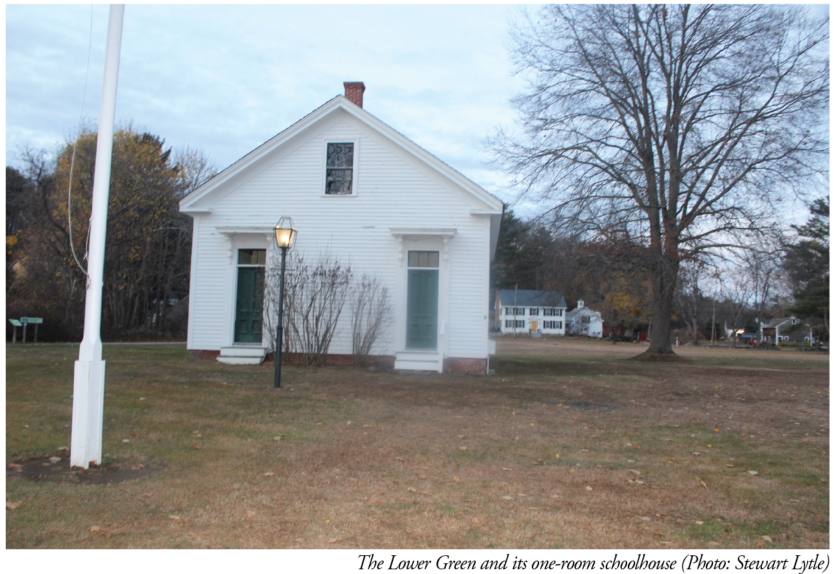NEWBURY – Settlers from Ipswich rowed up the Parker River in May of 1635 to establish this farming and trading community. They built a meeting house surrounded by one and two-room houses that were close together just north of the river to protect themselves from indigenous people and wild animals.
Soon, bigger houses, a cemetery and, of course, a tavern were built.
To graze cattle, sell their produce and hold meetings, the settlers set aside a small tract of land, now called the Lower Green, where they built a meeting house and a one-room schoolhouse. Today, the schoolhouse on the Lower Green, one of only 400 left in the country, is the sight of weddings and events and has become a popular stop on the Essex Coastal Scenic Byway (Rte. 1A).
In a community that treasures its history, one would expect that the Lower Green and its schoolhouse would have been protected decades ago from being torn down or encroached upon.
Not true. If the town government bowed to pressure from builders in years to come and sold off the Lower Green for development, there is little that outraged citizens could do to stop it.
That may change next year. The Lower Green Local Historic District Study Committee, authorized by the SelectBoard, is proposing to create a Local Historic District. The committee held three public meetings last week to discuss the creation of an LHD to protect the green, the schoolhouse and 16 homes and structures around it.
“We found that most people were unaware that there is currently no preservation protection for the Lower Green,” said Robin Etheridge, chair of the study committee and a resident of one of the 16 homes to be protected.
Working under the direction of the Massachusetts Historical Commission, the study committee has surveyed the area around the Lower Green, met with most of the property owners, conducted a survey of residents’ opinions on establishing the LHD and is preparing a preliminary report for state and local officials.
The proposed district, including its rules for any changes to structures in the district, must be approved by the state Historical Commission, followed by the Newbury SelectBoard and finally by a two-third majority vote at Town Meeting.
Etheridge hopes to present the proposed historic district to the Newbury Town Meeting next spring.
The Trustees of the Reservation, which owns a large property in the proposed district, wrote a letter of support. “Rather than preserving this landscape like a fly in amber, the Historic District would help ensure sensitive change in the area, change that respects and reinforces the cultural and historic qualities that have shaped the region,” wrote Peter Pinciaro, regional vice president, North Shore.
Pinciaro wrote that the Lower Green is “a remarkable survivor” of the development along the North Shore. Like a “three-dimensional textbook,” the area around the Lower Green should be preserved “while allowing sensitive change necessary for it to remain relevant and meaningful to those who pass through.”
The proposed district includes several historical homes, including the Dole Little House, built in 1715 and now owned by Historic New England; the Jackman Willett House, built in 1683 and now owned by the descendants of first settlers, and the Seddon Tavern, which was rebuilt after a fire in 1933 from materials salvaged from a 1728.
LHD regulations assure that the structures will not be harmed by “thoughtless renovations” of nearby properties, Etheridge said in his presentation this week.
Proposed renovations to existing homes, including demolition, will have to be approved by the new six-member LHD. The district’s review process will follow state and local laws and will be administered by local people, he said.
Some of the properties, which have opted out of the district, now have modern homes built on them.
Other, larger tracts are owned and already protected by Trustees of the Reservation.
“Older buildings give us a tangible link with our past. They tell stories of earlier times and become part of our lives. They provide a richness and depth to everyday life that cannot be replicated new construction and is lost when renovated beyond recognition,” Etheridge said.
Historic buildings “are rare and diminishing through demolitions and alteration. It is important that we take the first stop to turning conversation toward conservation and reuse,” he said.
Etheridge said studies show that local historic districts are a useful tool in increasing property values. “A community that values its history and architecture is generally one that is attractive to live in,” Etheridge said. ♦




